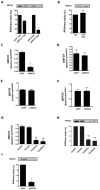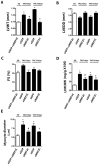MEF2C silencing attenuates load-induced left ventricular hypertrophy by modulating mTOR/S6K pathway in mice
- PMID: 20041152
- PMCID: PMC2794538
- DOI: 10.1371/journal.pone.0008472
MEF2C silencing attenuates load-induced left ventricular hypertrophy by modulating mTOR/S6K pathway in mice
Erratum in
- PLoS One. 2014;9(10):e112344
Abstract
Background: The activation of the members of the myocyte enhancer factor-2 family (MEF2A, B, C and D) of transcription factors promotes cardiac hypertrophy and failure. However, the role of its individual components in the pathogenesis of cardiac hypertrophy remains unclear.
Methodology/principal findings: In this study, we investigated whether MEF2C plays a role in mediating the left ventricular hypertrophy by pressure overload in mice. The knockdown of myocardial MEF2C induced by specific small interfering RNA (siRNA) has been shown to attenuate hypertrophy, interstitial fibrosis and the rise of ANP levels in aortic banded mice. We detected that the depletion of MEF2C also results in lowered levels of both PGC-1alpha and mitochondrial DNA in the overloaded left ventricle, associated with enhanced AMP:ATP ratio. Additionally, MEF2C depletion was accompanied by defective activation of S6K in response to pressure overload. Treatment with the amino acid leucine stimulated S6K and suppressed the attenuation of left ventricular hypertrophy and fibrosis in the aforementioned aortic banded mice.
Conclusion/significance: These findings represent new evidences that MEF2C depletion attenuates the hypertrophic responses to mechanical stress and highlight the potential of MEF2C to be a target for new therapies to cardiac hypertrophy and failure.
Conflict of interest statement
Figures







Similar articles
-
Berberine Attenuates Cardiac Hypertrophy Through Inhibition of mTOR Signaling Pathway.Cardiovasc Drugs Ther. 2020 Aug;34(4):463-473. doi: 10.1007/s10557-020-06977-z. Cardiovasc Drugs Ther. 2020. PMID: 32394178
-
AMP activated protein kinase-alpha2 deficiency exacerbates pressure-overload-induced left ventricular hypertrophy and dysfunction in mice.Hypertension. 2008 Nov;52(5):918-24. doi: 10.1161/HYPERTENSIONAHA.108.114702. Epub 2008 Oct 6. Hypertension. 2008. PMID: 18838626 Free PMC article.
-
Rapamycin attenuates load-induced cardiac hypertrophy in mice.Circulation. 2003 Apr 1;107(12):1664-70. doi: 10.1161/01.CIR.0000057979.36322.88. Epub 2003 Mar 17. Circulation. 2003. PMID: 12668503
-
RSK3: A regulator of pathological cardiac remodeling.IUBMB Life. 2015 May;67(5):331-7. doi: 10.1002/iub.1383. Epub 2015 May 19. IUBMB Life. 2015. PMID: 25988524 Free PMC article. Review.
-
[The pleiotropic role of MEF2C in bone tissue development and metabolism].Sheng Li Xue Bao. 2025 Apr 25;77(2):374-384. doi: 10.13294/j.aps.2025.0024. Sheng Li Xue Bao. 2025. PMID: 40326079 Review. Chinese.
Cited by
-
Myocyte-specific enhancer factor 2C: a novel target gene of miR-214-3p in suppressing angiotensin II-induced cardiomyocyte hypertrophy.Sci Rep. 2016 Oct 31;6:36146. doi: 10.1038/srep36146. Sci Rep. 2016. PMID: 27796324 Free PMC article.
-
Myocardial plasticity: cardiac development, regeneration and disease.Curr Opin Genet Dev. 2016 Oct;40:120-130. doi: 10.1016/j.gde.2016.05.029. Epub 2016 Aug 4. Curr Opin Genet Dev. 2016. PMID: 27498024 Free PMC article. Review.
-
MEF2 and the Right Ventricle: From Development to Disease.Front Cardiovasc Med. 2019 Mar 28;6:29. doi: 10.3389/fcvm.2019.00029. eCollection 2019. Front Cardiovasc Med. 2019. PMID: 30984767 Free PMC article. Review.
-
MEF-2 isoforms' (A-D) roles in development and tumorigenesis.Oncotarget. 2019 Apr 12;10(28):2755-2787. doi: 10.18632/oncotarget.26763. eCollection 2019 Apr 12. Oncotarget. 2019. PMID: 31105874 Free PMC article. Review.
-
The function of Mef2c toward the development of excitatory and inhibitory cortical neurons.Front Cell Neurosci. 2024 Sep 23;18:1465821. doi: 10.3389/fncel.2024.1465821. eCollection 2024. Front Cell Neurosci. 2024. PMID: 39376213 Free PMC article. Review.
References
-
- Katz AM. The cardiomyopathy of overload: an unnatural growth response in the hypertrophied heart. Ann Intern Med. 1994;121:363–371. - PubMed
-
- Opie LH, Commerford PJ, Gersh BJ, Pfeffer MA. Controversies in ventricular remodelling. Lancet. 2006;367:356–367. - PubMed
-
- Vakili BA, Okin PM, Devereux RB. Prognostic implications of left ventricular hypertrophy. Am Heart J. 2001;141:334–341. - PubMed
-
- Diwan A, Dorn GW., 2nd Decompensation of cardiac hypertrophy: cellular mechanisms and novel therapeutic targets. Physiology (Bethesda) 2007;22:56–64. - PubMed
-
- Chien KR. Stress pathways and heart failure. Cell. 1999;98:555–558. - PubMed
Publication types
MeSH terms
Substances
LinkOut - more resources
Full Text Sources
Miscellaneous

